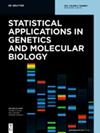Measuring evolutionary cancer dynamics from genome sequencing, one patient at a time
IF 0.9
4区 数学
Q3 Mathematics
Statistical Applications in Genetics and Molecular Biology
Pub Date : 2020-12-01
DOI:10.1515/sagmb-2020-0075
引用次数: 1
Abstract
Abstract Cancers progress through the accumulation of somatic mutations which accrue during tumour evolution, allowing some cells to proliferate in an uncontrolled fashion. This growth process is intimately related to latent evolutionary forces moulding the genetic and epigenetic composition of tumour subpopulations. Understanding cancer requires therefore the understanding of these selective pressures. The adoption of widespread next-generation sequencing technologies opens up for the possibility of measuring molecular profiles of cancers at multiple resolutions, across one or multiple patients. In this review we discuss how cancer genome sequencing data from a single tumour can be used to understand these evolutionary forces, overviewing mathematical models and inferential methods adopted in field of Cancer Evolution.通过基因组测序测量癌症的进化动态,每次一名患者
摘要癌症通过在肿瘤进化过程中积累的体细胞突变来发展,使一些细胞以不受控制的方式增殖。这种生长过程与塑造肿瘤亚群遗传和表观遗传组成的潜在进化力密切相关。因此,理解癌症需要理解这些选择性压力。广泛采用的下一代测序技术为以多种分辨率测量一名或多名患者的癌症分子谱开辟了可能性。在这篇综述中,我们讨论了如何使用单个肿瘤的癌症基因组测序数据来理解这些进化力,概述了癌症进化领域采用的数学模型和推理方法。
本文章由计算机程序翻译,如有差异,请以英文原文为准。
求助全文
约1分钟内获得全文
求助全文
来源期刊
CiteScore
1.20
自引率
11.10%
发文量
8
审稿时长
6-12 weeks
期刊介绍:
Statistical Applications in Genetics and Molecular Biology seeks to publish significant research on the application of statistical ideas to problems arising from computational biology. The focus of the papers should be on the relevant statistical issues but should contain a succinct description of the relevant biological problem being considered. The range of topics is wide and will include topics such as linkage mapping, association studies, gene finding and sequence alignment, protein structure prediction, design and analysis of microarray data, molecular evolution and phylogenetic trees, DNA topology, and data base search strategies. Both original research and review articles will be warmly received.

 求助内容:
求助内容: 应助结果提醒方式:
应助结果提醒方式:


